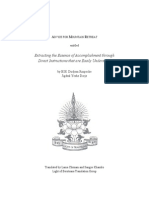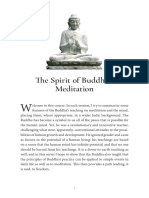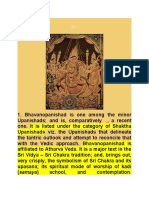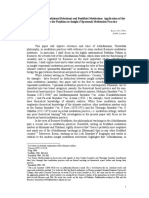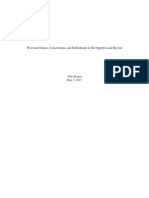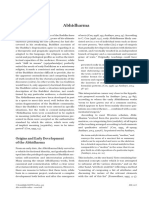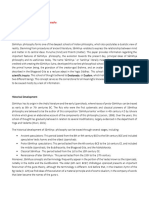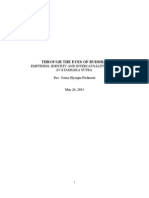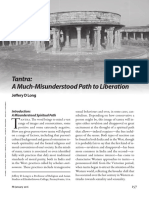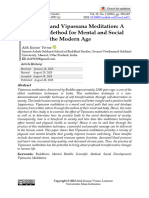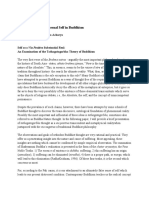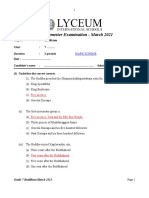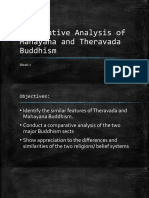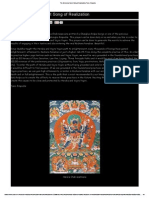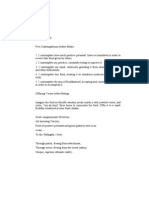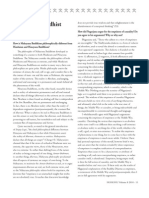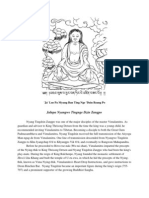On Freedom From Remorse AvipratisaraAvippatisara I
On Freedom From Remorse AvipratisaraAvippatisara I
Uploaded by
verachirino7196Copyright:
Available Formats
On Freedom From Remorse AvipratisaraAvippatisara I
On Freedom From Remorse AvipratisaraAvippatisara I
Uploaded by
verachirino7196Original Title
Copyright
Available Formats
Share this document
Did you find this document useful?
Is this content inappropriate?
Copyright:
Available Formats
On Freedom From Remorse AvipratisaraAvippatisara I
On Freedom From Remorse AvipratisaraAvippatisara I
Uploaded by
verachirino7196Copyright:
Available Formats
Mindfulness
https://doi.org/10.1007/s12671-024-02354-1
ORIGINAL PAPER
On Freedom from Remorse (Avipratisāra/Avippaṭisāra): Its Place
on the Well‑Trodden Path from Moral Discipline to Samādhi Meditation
Hao Sun1
Accepted: 12 April 2024
© The Author(s) 2024
Abstract
The primary objective of this study is to shed light on the role and significance of freedom from remorse
(avipratisāra/avippaṭisāra) in the cultivation of Buddhist concentration (samādhi) meditation. The study delves into the
progression from avipratisāra/avippaṭisāra to samādhi, examining how moral discipline influences an individual’s con-
science and, consequently, meditation. We commence by examining the well-established path of cultivation leading toward
samādhi. A comprehensive study was undertaken to understand the term avipratisāra/avippaṭisāra, its significance for Bud-
dhist meditation, the context in which it originated, and the various English translations that have been provided for it. Fur-
thermore, a comparison is made between avipratisāra/avippaṭisāra and a seemingly synonymous term, kaukṛtya/kukkucca,
with areas being sought where one or the other tends to be (or is exclusively) used within the discourse about Buddhist
ethics and meditation. From various Buddhist scriptures, it is suggested that a morally disciplined individual typically pro-
gresses through a series of states, starting with freedom from remorse and potentially leading to concentration (samādhi).
Avipratisāra/avippaṭisāra is pivotal in fostering positive meditative states, serving as a catalyst that propels individuals from
negative emotions to wholesome ones on the Buddhist path. By contrast, both vipratisāra/vippaṭisāra and kaukṛtya/kukkucca
are identified as basically synonymous words for disturbing emotions with somewhat different contexts of use, the elimination
of such emotions being necessary if individuals are to progress on their spiritual journey. Avipratisāra/avippaṭisāra plays
a crucial intermediary role bridging Buddhist ethics and meditation. Moral discipline and the subsequent understanding
and confession of any personal misconduct are integral to fostering freedom from remorse. Such freedom not only paves
the way to deeper meditation but also fortifies one’s confidence in Buddhist teachings, and so provides a foundation for true
spiritual progress.
Keywords Freedom from remorse (avipratisāra/avippaṭisāra) · Regret (kaukṛtya/kukkucca) · Moral discipline · The Five
Hindrances · Samādhi
Buddhist meditation, with its increasing resonance in the or pangs of remorse inevitably retard if not totally frustrate
modern world, illuminates a path toward tranquility and the journey? These reflections, steeped in the discourse of
enlightenment. However, despite its integration into contem- Buddhist thought for over two millennia, remain as relevant
porary lives, its ethical framework may appear to be more today as they were in the times of early contemplative explo-
nebulous than clear. The pertinence of moral grounding to ration, and typify the intricate interplay between ethics and
achieving meditative states poses thought-provoking ques- meditation that invites deeper understanding.
tions: Can meditation truly be practiced in a moral void? This exploration of ethical considerations in meditation
Could an individual of tainted conduct nevertheless tread is not a free-standing inquiry but rather embedded in the
a straight path to meditative attainment, or would slivers broader context of human behavior and spiritual progression.
In fact, various Buddhist traditions offer differing perspec-
tives, highlighting the necessity for a nuanced and multi-
* Hao Sun faceted approach when exploring the dynamic relationship
hao.sun@gmx.net
between morality and meditative practice. Ethical consid-
1
Numata Center for Buddhist Studies, University of Hamburg, erations become all the more complex in the current era,
Alsterterrasse 1, 20354 Hamburg, Germany where the essentials of Buddhist meditation are exposed to
Vol.:(0123456789)
Content courtesy of Springer Nature, terms of use apply. Rights reserved.
Mindfulness
adaptation and, at times, dilution. The myriad forces at play, from remorse.... It is natural that joy (pīti) arises in a
secular or otherwise, underscore the complexity of keeping person endowed with gladness.... It is natural that the
meditative practices necessarily aligned with moral integrity. body of one endowed with joy is calm.... It is natu-
One of the most common Buddhist meditative practices, ral that a person endowed with calmness (passaddhi)
samādhi, meaning (meditative) concentration (see Amaro, senses bliss (sukha).... It is natural that one concen-
2015; Anālayo, 2006; Bodhi, 2012; Ñāṇamoli & Bodhi, trates one’s mind when endowed with bliss. (Transla-
1995; Schmithausen, 2013; Vajirañāṇa, 1962), occupies a tion based on Bodhi, 2012, p. 1340)
key place in Buddhist teaching, constituting the second of
In Buddhist communities, it is widely believed that the
its three overarching divisions of the Eightfold Path between
Sutta Piṭaka, initially recited orally by the Buddha’s cousin
śīla/sīla (morality) and prajñā/paññā (wisdom). Given its
Ānanda at the First Buddhist Council, dates back to the
centrality, the prerequisites for samādhi have attracted much
fifth century BC. It later evolved into written scriptures,
scholarly attention being devoted to the nuanced back-and-
including the Aṅguttara Nikāya (AN), Dīgha Nikāya (DN),
forth between morality and concentration. Key contribu-
Majjhima Nikāya (MN), and Saṁyutta Nikāya (SN). Of the
tions to this discourse include Amaro’s (2015) insight that
four major Nikāyas just mentioned, the Aṅguttara Nikāya is
more carefully observed standards lead to a greater freedom
the largest one. It is characterized by well-edited Buddhist
from remorse, which in turn leads to better concentration,
discourses arranged in numbered sets, and therefore, it is of
and Anālayo’s (2009) reconsideration of what the Five Hin-
great importance to Theravāda Buddhism.
drances encountered along the path exactly entail. The San-
Coming back to the Pāli quotation from the Aṅguttara
skrit and Pali terms for the misconduct that leads to remorse
Nikāya, we find a version corresponding to it in the San-
or regret, along with other terms based on the same roots
skrit Śrāvakabhūmi (ŚrBh, p. 92). This latter text along
that denote freedom from such disturbances, will here come
with the Bodhisattvabhūmi occupies the oldest stratum of
under closer scrutiny.
the Yogācārabhūmi (the formative treatise of the Yogācāra
The pioneering studies directed toward understanding
school). Compiled in the third century AD, it was taken from
the samādhi-inducing practices include attempts to compre-
India to distant places in Central and East Asia. In the sev-
hend the mutually sustaining interaction between morality
enth century, it was translated into Chinese by Xuanzang 玄
and concentration within Buddhist teachings. The insights
奘. The observed consistency in the approach to concentra-
garnered from this body of work offer a multidimensional
tion across Theravāda and Yogācāra traditions is rooted in
view that takes in ethical and unethical conduct, internal
their reliance on texts, regarded as authentic teachings of the
responses to such conduct (including remorse and regret),
Buddha (Buddhavacana). Apart from their lengthy exposi-
and the collective impact on achieving states of samādhi. In
tions in the Aṅguttara Nikāya and Śrāvakabhūmi, we also
this paper, building upon existing scholarly work, I will elab-
encounter an abbreviated reference to the same process in
orate on the influence of ethics on an individual’s conscience
the Bodhisattvabhūmi (BoBh, p. 50):
and examine its subsequent impact on samādhi meditation.
In this way, a morally disciplined (śīlavat) person is
free from remorse (avipratisāra), experiences gladness
The Path of Cultivation of a Morally and so on, up to concentration (samādhi).
Disciplined Person Toward Concentration
Zimmermann (2013, p. 873) in a thorough study of
the wider meaning of śīla in the Bodhisattvabhūmi of the
According to a great number of traditional Buddhist
Yogācāra school presents a new slant on the word as used
works, a morally disciplined (śīlavat/sīlavat) per-
in the tenth chapter of the Bodhisattvabhūmi, the Right
son who seeks enlightenment will develop the states of
Conduct Chapter (Śīlapaṭala), namely as reflecting “both
avipratisāra/avippaṭisāra, gladness (prāmodya/pāmujja), joy
spiritual and emotional training as well as the appeal
(prīti/pīti), calmness (praśrabdhi/passaddhi), bliss (sukha),
to actively engage in the welfare of other living beings.”
and concentration (samādhi), in this fixed sequence. This lin-
Granted that, within this broader sense of morality, śīlavat
ear process of cultivation from avipratisāra/avippaṭisāra to
in the Bodhisattvabhūmi may also imply active social
concentration is reserved for persons of good conduct. One
engagement, in this paper it will primarily be confined to its
relevant passage from the Pāli Canon (AN 10.2, V 312) states
non-Mahāyāna definition along the lines of self-restraint,
this succinctly:
of which there are three aspects: (1) observing Buddhist
O Bhikkhus, it is natural (dhammatā) that freedom moral precepts: in the Nikāyas, sīlavat is often glossed as
from remorse (avippaṭisāra) arises in a morally dis- sīlasampanna, which denotes one who obeys the (Buddhist)
ciplined (sīlavat) person.... It is natural that gladness moral precepts (Sāmaññaphalasutta in DN 2); (2) maintain-
(pāmujja) arises in a person possessed of freedom ing moral discipline through such practices as confessing
Content courtesy of Springer Nature, terms of use apply. Rights reserved.
Mindfulness
and correcting transgressions (ŚrBh, p. 90); (3) turning this On the Concept Avipratisāra/Avippaṭisāra
obedience and maintenance of moral discipline into one’s
habit, so that one becomes an ever more morally disciplined The Negative Impact of Remorse and One of Its
person of noble character (cf. Böhtlingk and MW, s.v. as Antidotes
well as Schmithausen, 2001).
For the purpose of explaining the path of cultivation as it As stated in the above-quoted section of the Aṅguttara
figures in the present study, I offer the chart in Fig. 1. Nikāya, it is natural (dhammatā) that freedom from remorse
It is noteworthy that the above-mentioned path of cul- (avippaṭisāra) arises in morally disciplined (sīlavat) persons.
tivation, as a notion, is not simply preserved in the textual However, the passage does not expand on how to attain that
Buddhist Canon, but continues to be also deeply embedded state. In search of an answer, we shall first consider the defi-
in the Buddhist community. For example, in a dharma talk nition of śīla/sīla. According to the thorough study of it made
he gave in 1985, the popular contemporary Buddhist monk by Schmithausen (2001), this term is often used in Buddhist
Venerable Chanmyay Sayadaw recounts what went through contexts in the sense of impeccable conduct that has become
the mind of the Sri Lankan monk Mahātissa during one epi- second nature. The attribute śīlavat/sīlavat is accordingly
sode in his life: ascribable to persons exhibiting such ideal conduct, which
Reflecting on his spotless virtue, he experienced sounds in fact unattainable; no one matches up all the time
absence of remorse, gladness, rapture, tranquillity, and in real life. Does this imply that no Buddhist practitioner can
happiness. He observed all these mental processes as ever hope to attain true śīla/sīla from the outset, let alone
they really were. Observing the joy and gladness, the pass on to samādhi meditation in the future? The answer is
mind became happy and calm. (Sayadaw, 2004) obviously no. In practice, Buddhist monks and nuns regularly
hold a karman ritual within their Saṅgha communities and
These words reflect the above canonical version of the make confession of faults in front of their fellow monastics.
path of cultivation. Later his sermon was published and was Through confession practitioners can turn a page on the past
well received by local Buddhists. It is a modern exposi- and move on along on the path of cultivation extending from
tion of that well-trodden path toward samādhi meditation, avipratisāra/avippaṭisāra to concentration. One relevant pas-
on which spotless virtue corresponds to śīlavat/sīlavat, sage in the Śrāvakabhūmi reads as follows:
absence of remorse to avipratisāra/avippaṭisāra, gladness
to prāmodya/pāmujja, and so on. If a Buddhist practitioner who, introspecting, knows
Having identified the prominent role of avipratisāra/avippaṭisāra that, [in their own words], “My physical activity so
on the road to samādhi meditation, one might go on to ask whether far has caused injury or oppression”, [and later] that
samādhi is still attainable absent avipratisāra/avippaṭisāra. The Buddhist practitioner confesses (prati√diś) in front
Aṅguttara Nikāya (AN 10.3, V 313–314) provides a clear answer to of fellow practitioners endowed with [great] knowl-
this question: samādhi meditation lacks a proximate cause (upanisā) edge and corrects (prati√kṛ) [the fault] in accord-
for those deficient in the bliss resulting from the lack of avippaṭisāra. ance with [Buddhist] teachings; [and] if [then] that
Hence, it is hardly possible to steer clear of Buddhist practitioner, [still] introspecting, knows that
avipratisāra/avippaṭisāra if we want to comprehend the “My physical activity is no longer detrimental [to oth-
causal chain leading to samādhi meditation. In fact, very lit- ers]”, and practises many days and nights with joy
tle research has been done on this fundamental concept. In and gladness, then that Buddhist practitioner, intro-
the pages that follow, I will expand on it, focusing on the cir- specting well, [knows] that their physical activity is
cumstances in which it arises, its role in Buddhist meditation, purified (suviśodhita) in the past, present and future
and the multiple choices of English translations offered for it. time. Likewise, verbal activity should also be under-
stood in this way. (Translation based on ŚrBh, p. 90)
Fig. 1 The path of cultivation for one morally disciplined, via avipratisāra/avippaṭisāra and so on toward concentration (samādhi) meditation
Content courtesy of Springer Nature, terms of use apply. Rights reserved.
Mindfulness
The Śrāvakabhūmi thus offers a practical way to purify and kukkucca—in the case of the Buddha’s contempo-
bad deeds, namely by confessing in front of fellow devo- rary followers who had been morally slack—forgiveness
tees and then rectifying one’s faults in accordance with begged for in his presence. Given that the historical Bud-
Buddhist teachings. After this procedure, one again dha passed away more than two thousand years ago, this
focuses introspectively on one’s own activity in order to is now out of the question, but confession, this time in
know whether it has been purified. If it has, one can be front of knowledgeable fellow devotees, as described in
confident of having restored moral self-discipline and of the Śrāvakabhūmi, is still a feasible recourse for the back-
once again being pure in conduct (śīlaviśuddhi). Thus, slider who wishes to embark on the path toward samādhi.
free from remorse (avipratisāra), one proceeds on along In addition to their differing in the matter of
the path toward concentration. The above passage in par- the Buddhaʼs presence, the Śrāvakabhūmi and the
ticular shows that avipratisāra is contingent upon facing Bhaddālisutta further exhibit two distinct scenarios: (1)
up to a misdeed directly, confessing it, and then taking offenders become aware of their transgressions on their
countermeasures whenever a person’s conduct has caused own, and make their confession in front of others. Through
injury or oppression to others. According to this source, confession, remedy, and practice, they are able to return to
then, avipratisāra is not attained as long as one refuses to living in good conscience at having atoned; (2) offenders
address the matter or even simply ignores it. at the beginning feel justified for the wrong committed,
In comparison, the Bhaddālisutta (MN 65, I 437–440) but in course of time they come to feel utterly distressed.
associates the overcoming of vippaṭisāra and kukkucca During confession, they are made to see why what they
with beseeching forgiveness. At the very beginning, did was wrong, and only then do they feel remorse, but
for his own sake, Venerable Bhaddāli refused to accept they soon come to realize that confession and remorse has
the Buddha’s advice of eating a single meal during the purified them, and so do not need to let the incident be
day, and claimed that he would be consumed by remorse an albatross around their neck. (This summary is kindly
(vippaṭisāra) and feel the hindrance of regret (kukkucca) provided by Mr. Pierce.)
if he followed it. Then, in the next three months, he did not Through proper confession, Buddhist practitioners can
feel easy and avoided the Buddha’s presence. His fellow overcome distress and turn a new leaf. The other option is
monks comprehended his distress, and comforted him by to remain stuck in that state for a long time without finding
saying: “Please, friend Bhaddāli, learn your lesson. Do not a way out. This theme occurs over and over in Buddhist
let it become more difficult for you later on.” Venerable literature.
Bhaddāli was relieved, came to the Buddha, and apolo- In the Visuddhimagga, composed by Buddhaghosa
gized. He expressed his regret and remorse, and pled with (Theravāda’s most famous commentator and translator),
him: “Sir, please accept my mistake for what it is, and I it is again stressed (Vism, p. 54) that moral shortcomings
will restrain myself in future.” The Buddha well under- are displeasing to both deities and human beings, leading
stood his mental states—feeling empty, hollow, and guilty to censure and remorse (vippaṭisāra). Interaction with the
(ritto tuccho aparaddho)—in the previous three months, unreinstated is painful, and those who resist an accounting
probingly taught him why he was wrong, and accepted face long-lasting suffering in a state of loss.
his confession. Afterwards, the Buddha elaborated on One story (SuVi, p. 19) in the first volume of the Pāli
the Dharma, telling of a monk capable of meditating but Vinaya (the Buddhist monastic code) describes the stress of
who lived withdrawn and unreprimanded by a teacher, by a regretful (kukkucca), remorse-stricken (vippaṭisāra) monk,
knowledgeable fellow monks, by deities, or by himself. Venerable Sudinna. His inner unrest occasions a whole
It is quite interesting that Venerable Bhaddāli talked series of worsening states: he becomes increasingly hag-
about regret and remorse on two different occasions: at gard and wretched. The whole panoply of physical problems
first as a possible outcome of accepting the Buddhaʼs sug- that brought about his mental suffering is vividly captured
gestion. His hesitancy can be expressed in words still heard in Horner’s translation (1982, p. 34).
today: “I will regret it later if I do this now.” Then later, Besides Pāli sources, the Chinese translation of the
after prolonged distress, he actually did become remorse- *Mahāprajñāpāramitāśāstra amplifies the way remorse
ful. The reason was a hollow feeling of guilt during three and regret (in the Chinese translation 悔huǐ appears for
months of self-imposed isolation from the Buddha, during vippaṭisāra or kukkucca) disturbs one’s peace of mind, and
which he lost his grip on what he thought was a perfectly spiritual cultivation as well (T1509, 25, 184c11–21):
right and normal way of life. His fellows understood his
Persons who are prey to regret are like a criminal
predicament, comforted him, and guided him to the right
always tortured by fear. When the arrow of regret
re-entry point on the path: confession.
has entered the mind, it is implanted there and can-
The dialogue in the Bhaddālisutta makes as a pre-
not be removed. Some stanzas say: if they have done
condition for overcoming the suffering of vippaṭisāra
Content courtesy of Springer Nature, terms of use apply. Rights reserved.
Mindfulness
what they should not do, if they have not done what Canon (AN 10.1 at AN V 2). On the one hand, as my previ-
they should have done, they are burned by the fire of ous citation from Visuddhimagga 2.1 shows, being trapped
remorse. Later they will fall into bad destinies. (Based in a feeling of vippaṭisāra is compared to living through
on the translation by Gelongma, 2001, p. 789) a seemingly endless state of loss (apāya); by contrast, the
avippaṭisāra state is described in terms of benefit/gain
To sum up, in the Buddhist view, as long as one is
(ānisaṃsa).
assailed by remorse, one cannot easily lead a normal,
One can imagine the elation felt by someone in debt once
peaceful life, let alone attain higher meditative goals. For
that debt has finally been paid off; something similar can
anyone consumed by remorse, the first need is to attain
be expected to happen to a Buddhist who attains freedom
avipratisāra/avippaṭisāra.
from remorse (avipratisāra/avippaṭisāra) following a long,
torturous period plagued by vipratisāra/vippaṭisāra. That
The Significance of Avipratisāra/Avippaṭisāra is doubtless why avipratisāra/avippaṭisāra plays such a
for Meditation prominent role in Buddhist meditation: it marks the turning
point, transforming negative feelings into positive states, just
Having investigated the contexts and import of avipratisāra as turning loss into gain in our worldly lives does, through
in the Sanskrit text Śrāvakabhūmi, I shall now turn to the which a downward spiral can be broken and reversed, and
Pāli term avippaṭisāra, focusing on its morphology as set life turned around. To put it in a nutshell, the attainment
forth in the Theravāda commentary. To start off, the word of avipratisāra/avippaṭisāra serves as the starting point
can be resolved into the negative prefix a- and the rest of in the direction of successively more wholesome states
word, vippaṭisāra, this being the antonym of the whole (including meditative ones) along the Buddhist path. In
form. And as for the morphology of vippaṭisāra, the most what follows, I will discuss various English translations of
renowned and authoritative Pāli commentator, Buddhag- avipratisāra/avippaṭisāra.
hosa, writing in his exegesis of the Dhammasaṅgaṇī (AS,
p. 384), provides a detailed elucidation, as follow: Alternative Translations of Avipratisāra/
Avippaṭisāra
… vippaṭisāra of the mind is [first of all a mental]
journey [backwards] to (abhimukhagamana) what
In my understanding of the term, avipratisāra/avippaṭisāra
has already been done or not done, what is blamable
can be translated in at least a threefold manner: (1) absence
or what is not blamable. One does not get bad deeds
of remorse, non-regret, or lack of regret; (2) a clear con-
[done in the past] undone or good things [undone in
science; and (3) freedom from remorse. The subtle difference
the past] done. Therefore, this retrospective (paṭisāra)
between the first and third options is that the absence or lack
[mental journey] is unnatural (virūpa) and contempt-
of remorse does not rule out its eventual appearance, while
ible [in the mind of that person]. Thus is [the word]
freedom from it implies that one has effectively been rid of it
vippaṭisāra [formed] (i.e., vi- from virūpa plus the
in the long term. Considering that remorse and regret causes
form paṭisāra). It [describes a state] of mind, not
worry and unease, which is not beneficial to meditation, it is
[simply] of sentient being, whence vippaṭisāra is
not something wanted by serious practitioners.
said in relation to the mind. This is an exposition of
The “absence of remorse,” “non-regret,” or “lack of regret”
vippaṭisāra’s formal nature.
are long-established translations of avipratisāra/avippaṭisāra
In the view of Buddhaghosa, then, the prefix vi- in adopted by a number of eminent scholars. There is some merit
vippaṭisāra is shorthand for the word virūpa: an unnatural to them, but my main focus will be on to the other two, namely
(vi-) retrospective mental journey (pratisāra/paṭisāra) is (2) and (3).
called vipratisāra/vippaṭisāra. Firstly, there is obviously not much difference among
For those plagued by remorse, it goes without saying that the established expressions, be they “absence of remorse,”
they find no inner peace and happiness by recollecting the “non-regret,” or “lack of regret”: they all denote the contrary
past, let alone attain higher meditative states. One might of regret or remorse. To give a review of these renderings,
liken the torture of vipratisāra/vippaṭisāra in the Buddhist Vajirañāṇa (1962, p. 57) summarizes a passage from the
context to sinking deeply into debt. Both bear certain simi- Kimatthiyasutta in the Aṅguttara Nikāya with the words “…
larities: (1) they are both long-lasting depressing situations; the benefit and advantage of moral virtues is the absence of
(2) they both may easily plunge one into a downward spiral remorse (avippaṭisāra)…. Morality (sīla) is of paramount
difficult to get out of; (3) but if the situation can be over- importance in meditation.” Whitaker & Smith (2018, p. 57)
come, the sense of relief is overwhelming. stress that “lack of regret (avippaṭisāra) is critical to the
The association between vippaṭisāra and loss, and development of open, clear and focused mindfulness. It is
avippaṭisāra and benefit, is exactly preserved in the Pāli also essential for right concentration.”
Content courtesy of Springer Nature, terms of use apply. Rights reserved.
Mindfulness
It is noticeable that all the above translations of conscience” for avipratisāra/avippaṭisāra imposes
avipratisāra/avippaṭisāra are framed negatively, with itself. So expressed, it appears as a positively
either the negative prefix non- or the negative phrases expressed phrase from the outset, in line with all the
“lack of” or “absence of” at the beginning, corresponding other states along the path of cultivation. And like
to the negative prefix a- in Sanskrit or Pāli. At first sight, avipratisāra/avippaṭisāra and vipratisāra/vippaṭisāra,
these seem to be utterly unproblematic renderings. How- “clear conscience” and “bad conscience” form a pair
ever, non-regret, lack of regret, and absence of remorse all of opposites rather than one simply being the contrary
stand out against the other beneficial states: morally dis- (i.e., negation) of the other.
ciplined (śīlavat/sīlavat), gladness (prāmodya/pāmujja), In spite of the advantages that “clear conscience”
joy (prīti/pīti), calmness (praśrabdhi/passaddhi), bliss offers, it does not fully highlight actual function of
(sukha), and concentration (samādhi) on the path of cul- avipratisāra, especially the turning point transforming
tivation, which all are unequivocally affirmative terms. negative feelings into positive states as elaborated in
Heim (2014, p. 116) points out this apparent discrepancy “The Subtle Differences Between Kaukṛtya/Kukkucca
when she states that the presence of an absence (non- and Vipratisāra/Vippaṭisāra” section. Finally, I choose
remorse) is what makes possible the other processes. In the third option, “freedom from remorse,” as the work-
my opinion, it is possible, and perhaps even preferable, ing definition for avipratisāra/avippaṭisāra. In the
to render the term avipratisāra/avippaṭisāra so that it first place, the phrase “freedom from x,” indicating a
aligns with the affirmative form of all the other progres- state free from a negative condition, such as pain, fear,
sional terms. One such candidate for the translation of and worry, faithfully reflects the Sanskrit or Pāli pre-
avipratisāra/avippaṭisāra would be “clear conscience.” fix a- in avipratisāra/avippaṭisāra. In the second place,
Let us consider this English phrase. As far as I can see, avippaṭisāra, like gladness (pāmujja), joy (pīti), calm-
it largely reflects the meaning of avipratisāra/avippaṭisāra ness (passaddhi), and bliss (sukha), expresses a positive
in two respects. In the first place, “clear conscience” means quality (guṇa), as repeatedly described in the Visuddhim-
“a knowledge or belief that one has done nothing bad or agga: “the gaining of multiple good qualities starting from
wrong,” according to the Merriam-Webster English Diction- avippaṭisāra is the benefit of sīla” (kim ānisaṃsaṃ sīlanti,
ary. This definition appears to comport with the literal mean- avippaṭisārādi anekaguṇapaṭilābhānisaṃsaṃ, Vism, p.
ing of avipratisāra/avippaṭisāra in the Buddhist contexts, as 9). In this sense, to translate avippaṭisāra neutrally as non-
discussed in “The Significance of Avipratisāra/Avippaṭisāra remorse would not do full justice to its positive nature, let
for Meditation” section. Moreover, as reported by Cotting- alone connote its sense here of ultimate immunity from
ham, a British scholar known for his research in the philoso- recurring remorse in the future. We already know that the
phy of religion and moral philosophy, “a clear conscience Pāli Canon draws an analogy between vippaṭisāra and loss
occurs when someone’s inner reflection leaves him/her in (apāya). As the contrary of loss implies a certain free-
the happy position of finding nothing wrong with how he/ dom from loss, so too remorse and freedom from remorse
she has behaved” (Cottingham, 2013, p. 731). This again form a similar pair. In the third place, the phrase “freedom
matches up with the inner state that a practitioner needs to from remorse” conveys a positive sense as a whole. Given
attain on the path of cultivation toward samādhi. In the sec- that “bad conscience” is not an established translation for
ond place, Vithoulkas & Muresanu (2013, p. 105) and other vipratisāra/vippaṭisāra, for now I shall stick with its com-
neuroscientists have determined that “a clear conscience has mon rendering “remorse” and apply a new term only to the
the advantage of feeling inner peace.” This, in my opinion, translation of avipratisāra/avippaṭisāra. Actually, Amaro
encapsulates the progression from avipratisāra/avippaṭisāra (2015, p. 70) already briefly mentions that “through living
to sukha. ethically and responsibly, freedom from remorse arises.”
In previous studies, vipratisāra/vippaṭisāra is some- Although in his paper he does not offer the Pali words
times indeed translated as “bad conscience.” Horner for freedom from remorse, it is very likely avippaṭisāra.
(1982, p. 172) argues that vippaṭisārī, the adjective form I believe that it is him who firstly coins this translation.
of vippaṭisāra, comes close to that underlying meaning The passage from the Bhaddālisutta cited in “The Neg-
(“self-recrimination” would be another term for it). She ative Impact of Remorse and One of Its Antidotes” con-
further comments that “words for conscience are sadly tains two terms that convey some sense of remorse and
lacking in Pāli, but this may be an attempt to express regret: vippaṭisāra and kukkucca. In the following section,
the idea of it, emerging in the sixth century B.C.” The I will juxtapose vipratisāra/vippaṭisāra with its compan-
entry in the PTSD includes it among the synonyms of ion kaukṛtya/kukkucca, with a special focus on their rel-
vippaṭisāra along with “remorse,” “regret,” and “repent- evance to meditation and ethics. A deeper study of these
ance.” Once “bad conscience” is accepted as a fit trans- two terms ought to help us gain a deeper understanding of
lation for vipratisāra/vippaṭisāra, the translation “clear avipratisāra/avippaṭisāra as well.
Content courtesy of Springer Nature, terms of use apply. Rights reserved.
Mindfulness
On Buddhist Notion of Remorse and Regret Their bodily inertia has not fully subsided, sloth and
torpor have not been fully eliminated, their excite-
The Similarities Between Vipratisāra/Vippaṭisāra ment and regret have not been fully removed; because
and Kaukṛtya/Kukkucca of this, one meditates, as it were, dimly. Their bod-
ily inertia has fully subsided, sloth and torpor have
In Buddhist literature, vipratisāra/vippaṭisāra and been fully eliminated, their excitement and regret have
kaukṛtya/kukkucca are the two most frequent terms used been fully removed; because of this one meditates, as
for describing the feeling of remorse and regret. The early it were, brightly. (Translated after Ñāṇamoli & Bodhi,
co-presence of these two terms is preserved not only in 1995, p. 1006)
the Bhaddālisutta of the Majjhima Nikāya, but also in Secondly, it is notable that the mental progression of a
the Vakkalisutta (SN 22.87, III 119), Assajisutta (SN morally disciplined Buddhist who abandons the Five Hin-
22.88, III 125), Paṭhamagilānasutta (SN 35.74, IV 46), drances coincides with the path of cultivation expressed
and Dutiyagilānasutta (SN 35.75, IV 47) of the Saṃyutta in terms of avipratisāra/avippaṭisāra, passing through the
Nikāya, and in the Saṅkavāsutta (AN 3.92, I 237) of the same intermediate states from gladness, joy, calmness, and
Aṅguttara Nikāya. In these texts, each monk (Bhaddāli, bliss to samādhi, as asserted, for instance, in DN 2, I 70–73:
Vakkali, Assaji, or Kassapagotta, depending on the sutta)
is assailed by what is called either vippaṭisāra or kukkucca. When practitioners possess this entire spectrum of
More important than the monks themselves are the situa- noble ethics, they experience the happiness arising
tions which lead them to their feeling of regret and remorse, from blamelessness inside…. When those practitioners
and whether each case is unique or else whether they can be perceive that the Five Hindrances have left them, glad-
categorized under a small group of different types, whether, ness arises; those who are glad have joy; practitioners
that is, there is one or more distinct narratives of regret and possessed of joy calm [their] body; practitioners pos-
remorse offering a kind of formula that could be applied sessed of corporeal calm feel bliss; practitioners pos-
to various monks in multiple suttas. The second possibility sessed of bliss concentrate [their] mind. (Translation
lends itself to explanation through Shulman’s recent theo- after Sujato, 2018b)
rizing, namely that “(early Buddhist) discourses (sutta) can The above citation ascribes the happiness of morally dis-
be seen as legitimate combinations of formulas, shaping ciplined persons to their blamelessness (anavajja), which
texts out of formulas much like children may create differ- is the objective moral state corresponding to freedom from
ent buildings with the same blocks or Legos” (Shulman, remorse (avippaṭisāra). It leads on to gladness, joy, and the
2022, p. 558). other states. It appears to be merely a matter of perspective
Frequent instances of the co-presence of two terms relat- whether we approach the path of cultivation of a morally
ing to regret and remorse in the Nikāyas can be chalked disciplined person via freedom from remorse (avippaṭisāra)
up as synonymous usage. Three characteristics common to or via elimination of the Five Hindrances (including the hin-
both vipratisāra/vippaṭisāra and kaukṛtya/kukkucca are as drance of regret, i.e., kukkucca).
follows: (1) both are disturbing emotions, (2) one can [re-] Thirdly, vipratisāra/vippaṭisāra or kaukṛtya/kukkucca can
embark on the chosen path of cultivation after eliminating be improperly engendered by another person who does not
either, (3) both are felt by someone who does not act in act in line with Buddhist teachings. In the Vinaya litera-
accordance with Buddhist teachings. ture, for instance, we encounter multiple accounts of one or
In the last section, I discussed the negative effect of another monk who deliberately engages in wicked behavior
vipratisāra/vippaṭisāra. Now I turn to kaukṛtya/kukkucca. (kaukṛtya/kukkucca) that impacts his fellow monks and that
It is often categorized under the Five Hindrances (pañca calls for repentance; he is accused and penalized according
nīvaraṇāni) in Buddhist literature, which are the follow- to Buddhist regulations. AN 5.167, III 197 reveals that being
ing: (1) the hindrance of longing for sensual pleasure; accused of a fault in any one of five improper ways removes
(2) the hindrance of malice; (3) the hindrance of sloth the burden imposed by remorse (vippaṭisāra). There, the
and torpor; (4) the hindrance of excitement (uddhacca) Buddha addresses monks as follows:
and regret (kukkucca); and (5) the hindrance of doubt. A
Pāli version of this is seen, for instance, in DN 13 at DN The monk who is accused improperly should be reas-
I 246, with a Sanskrit correspondence in Samāhitābhūmi sured in five ways. “(1) Venerable, you were accused
§ 2.2.0 (SamBh, p. 131). at the wrong time, not at the right time. There’s no
What the Five Hindrances impede is meditative practice. need for you to feel remorse. (2) You were accused
After eliminating them, one can finally meditate “brightly,” falsely, not truthfully…. (3) You were accused
as declared in the Majjhima Nikāya (MN 127 at MN II 151): harshly, not gently.… (4) You were accused harm-
Content courtesy of Springer Nature, terms of use apply. Rights reserved.
Mindfulness
fully, not beneficially…. (5) You were accused out of So far, I have analyzed in detail the similarities between
secret hatred, not lovingly. There’s no need for you to two words for remorse and regret. Due to such commonal-
feel remorse”. (Translation based on Sujato, 2018a) ity, vipratisāra/vippaṭisāra serves frequently as a gloss of
kaukṛtya/kukkucca. In the Sanskrit Pañcaskandhaka, the
Now, I shall turn to cases specifically involv-
link is clear and concise: “What is kaukṛtya? It is vipratisāra
ing kaukṛtya/kukkucca. In the Prātimokṣasūtra of the
in mind” (kaukṛtyam katamat. cetaso vipratisāraḥ, PS, p.
Sarvāstivāda Vinaya under Pātayantikā 62 (PrMo, p. 225),
13).
it is noted that a monk who is judged to have deliberately
Likewise, both the Sanskrit Abhidharmakośabhāṣya and
committed a kaukṛtya fault affecting his fellow monks’
Pāli Mahāniddesa also use vipratisāra/vippaṭisāra to gloss
practice is guilty of a pātayantikā transgression:
kaukṛtya/kukkucca:
Again, when a monk, having considered harming
Kaukṛtya is an abstract noun denoting some base act
(viheṭhenā) another monk, intentionally commits
(kukṛta), but here kaukṛtya is said to be a dharma that
kaukṛtya against another monk, and hopes the other
has kaukṛtya as the object underlying it, viz., remorse
monk will feel unpleasantness, if even only for one
(vipratisāra). (AbhKBh, p. 57)
instant, then his having caused this is a straightfor-
Kukkucca, making one become kukkucca, the state of
ward pātayantikā violation.
being made kukkucca, mental vippaṭisāra and mental
In the Buddhist Vinaya, pātayantikā in Sanskrit (or perplexity (manovilekha)—these are [all] called kuk-
correspondingly pācittiya in Pāli) stands as one of the kucca. (Nidd, p. 375)
three major kinds of monastic transgressions, which rel-
All this being said, these two terms are not always inter-
egate Buddhist practitioners to an evil existence in the
changeable despite the great number of situations in which
next life if they do not repent and make expiation. One
they appear to be so. In what follows, I will move on to the
reason that such a deed is penalized so severely is that it
nuances evinced by the pair, with a special focus on their
may impede the meditative practice of another monk, who
relationship to Buddhist ethics and meditation.
may well be morally disciplined but may fail to perfect
his concentration in the wake of the disturbance. On the
The Subtle Differences Between Kaukṛtya/Kukkucca
other hand, if in line with Buddhist teaching one monk
and Vipratisāra/Vippaṭisāra
causes another monk to commit an offense for which the
latter should be regretful, he himself does not commit
The nuances that attach to the two main words for regret and
pātayantikā/pācittiya. It is always, in any case, the duty
remorse in Buddhist literature manifest in primarily three
of an elder monk to act as a preceptor to junior monks, as
areas: (1) their association (or lack thereof) with excitement
stressed by Anālayo (2009, p. 66).
(auddhatya/uddhacca) to form one of the Five Hindrances,
In the Pāli Vinaya Suttavibhaṅga (SuVi II, 149), the
(2) the widening gap between their respective usages in rela-
finger was explicitly pointed at a group of six monks
tively late Buddhist primary sources, (3) their relationship
(chabbaggiyā bhikkhū) who deliberately caused other
to Buddhist ethics and meditation.
monks to feel kukkucca, and hence faced the following
First of all, kaukṛtya/kukkucca is the word used
expiation:
consistently in the list of the Five Hindrances,
Now at that time the group of six monks intentionally vipratisāra/vippaṭisāra appearing in this context, as far as
aroused regret in a group of seventeen monks.... [The I can tell, never. Kaukṛtya/kukkucca always appears as the
Buddha addressed the assembled:] “Whatever monk fourth hindrance along with auddhatya/uddhacca. Studies
intentionally arouses remorse in a[nother] monk, conducted by modern scholars, starting with Rhys Davids in
thinking, ‘There will be no comfort for him even for the early twentieth century, have landed on “excitement” as
a moment’—if having done this precisely for this probably close to the intended meaning of uddhacca. Cous-
reason, not for another, there you have an offence ins (1973, p. 118) further holds that “uddhacca-kukkucca
requiring expiation (pācittiya)”. (Translation based seems to refer to states of a mildly manic-depressive nature.”
on Horner, 1982, p. 53) Schmithausen (2013, p. 477) is among the large number of
scholars who have adopted the translation “excitement.”
This shows that forcing morally disciplined monks to
Though it is not directly linked with uddhacca,
needlessly feel regret is condemned by the Buddha in a
avippaṭisāra results from the elimination of the fourth
Pāli source along the same lines as previously mentioned.
hindrance. The Visuddhimagga (Vism, p. 189) states that
It should be noted, however, that the activities of groups of
excitement (uddhacca) and regret (kukkucca) are abandoned
six monks in Buddhist Vinaya texts were often intended to
through cultivation of a peaceful frame of mind. Peace is the
be perceived as comic (Schopen, 2007, p. 218).
means used as well as the aim sought by those experiencing
Content courtesy of Springer Nature, terms of use apply. Rights reserved.
Mindfulness
regret. In the Majjhima Nikāya (MN 27, 38, 39), it is empha- Hindrances, malice (vyāpāda) is unethical without ques-
sized that once one abandons excitement and regret, one tion. Longing for sensual pleasure (kāmacchanda) and
abides unagitated (anuddhata) with an inwardly (ajjhattaṃ) sloth (thina) cannot be regarded as good conduct. Regret
peaceful mind (upasantacitta). (kaukṛtya/kukkucca) arises most frequently in matters of
One unique story in a Mahāyāna Buddhist sutra, the personal conduct, and so is also closely bound to ethics.
Ajātaśatru-kaukṛtya-vinodanā-sūtra, centers on kaukṛtya. As to the last hindrance, doubt (vicikicchā), in Bud-
It presents King Ajātaśatru as having dispelled kaukṛtya dhism it refers specifically to uncertainty about the Bud-
through a sustained consideration of the notion of emptiness dha, the Dhamma, the Saṅgha, the path, or the practice
(śūnyatā) in relation to the problems of moral responsibil- (see, for example, AN 4.76 at AN II 79). Such doubt, and
ity and personal continuity that arose from his unspeakable the inability to escape from it, prevents one from know-
crime of patricide (Hartmann & Harrison, 1998). No coun- ing what is one’s own good and the good of others (cf.
terpart is attested with vipratisāra/vippaṭisāra substituted AN 5.193 at AN III 233). It is intimately associated with
for kaukṛtya/kukkucca in Buddhist literature. I surmise Buddhist ethics, inasmuch as, in the first place, it is able
that the reason may have something to do with the consist- to undermine ethical foundations and, in the second place,
ency with which kaukṛtya/kukkucca is featured under the cause harm to oneself and others.
Five Hindrances. This association was so firmly ingrained If we assume that the vippaṭisāra pattern and the cor-
that the Ajātaśatru-kaukṛtya-vinodanā-sūtra chose the responding kukkucca pattern overlap, then a morally dis-
term kaukṛtya, and amplified it together with its antidote: ciplined person ought also to be free from the Five Hin-
emptiness. drances, so that not only is good conduct achieved, but
The part regret plays in Buddhist ethics and meditation also confidence in future deeds and a firm Buddhist ethical
deserves special attention. For morally disciplined per- foundation are built. A broader investigation of Buddhist
sons, the attainment of samādhi is assured along the path ethics, however, is beyond the scope of this study.
of cultivation that starts from avippaṭisāra. As the primary Last but not least, I tend to translate
sources cited in the introduction above affirm, it is natu- vipratisāra/vippaṭisāra as remorse, and kaukṛtya/kukkucca
ral (dhammatā) that freedom from remorse (avippaṭisāra) as regret in this paper. Thanks to the kind reminder by Mr.
should come to be established in such persons. The path Philip Pierce, in English, remorse is generally a strong emo-
from that point on to mastery of meditative concentration is tion, whereas regret spans a wider range of emotion (it can
linear and straightforward. be strong or weak). When we bear this in mind and con-
However, things are more complicated in the correspond- sider in Buddhist context, it appears that kaukṛtya/kukkucca
ing path of cultivation requiring that kaukṛtya/kukkucca be generally covers a wider range of emotion than that of
countered, for a kaukṛtya disturbance may even befall a vipratisāra/vippaṭisāra. In the Pāli Mahāniddesa, it is stated
morally disciplined person, having been instigated by some- that term kukkucca, making one become kukkucca, the state
one else, as revealed in the medieval Chinese translation of being made kukkucca, mental vippaṭisāra, and mental
of the Buddhist Vinaya. As some portions of the Sanskrit perplexity (manovilekha)—these are [all] called kukkucca
Sarvāstivāda Vinaya are not existent, we often, when deal- (Nidd, p. 375). In the Sanskrit Samāhitābhūmi, the term
ing with the background of (Mūla)-Sarvāstivāda sources, kaukṛtya is elucidated in the following way, covering truly
consult a corresponding Chinese translation such as the 根本 a wider range of emotion, thus fit the semantics of “regret”
說一切有部毘奈耶 Gēn-běn shuō-yī-qiè-yǒu-bù pí-nài-yē better than vipratisāra/vippaṭisāra.
translated by Venerable Yijing 義淨 at the beginning of the
What is kaukṛtya? [1] For ones who are reflecting/
eight century A.D. This translation contains a lengthy nar-
making rough examination (vitarkayat) on their kins-
rative (T1442, vol.23: 848a18–b21) exactly replicating the
men and so on (jñātyādi), [and thinking]: “Why did I
setting of the Sanskrit version of the Prātimokṣasūtra of
leave my kinsmen? Why did I not go to that commu-
the Sarvāstivādins cited above in “The Similarities Between
nity? Why did I leave that community and come here
Vipratisāra/Vippaṭisāra and Kaukṛtya/Kukkucca,” where
(tyaktvehāgata), where such food is eaten, such drink
kaukṛtya in the sense of regret is translated as 追悔 zhuī-
is taken, and such dress (cīvara), alms (piṇḍapāta),
huǐ. It revolves around a monk who, having committed no
sleeping place (śayana), seat (āsana), medicament
transgressive faults (in Chinese: 無過 wú guò, indicating
having sickness as its cause (glānapratyayabhaiṣajya)
that he was morally unblemished), still suffered from the
and personal belongings (pariṣkārā) are obtained?
kaukṛtya disturbance.
Why did I become a monk at young age? It should be
Whoever is assailed by kaukṛtya cannot concentrate
made (becoming a monk) when I am old!”,
well upon the eradication of the taints (āsava). Precisely
[2] or when remembering former jokes and recreation
speaking, of course, each of the other hindrances impedes
and so, [and thinking]: “Why did I at that time amuse
concentration (see AN 5.23 at AN III 16). Among the Five
Content courtesy of Springer Nature, terms of use apply. Rights reserved.
Mindfulness
myself with recreation, enjoyment, and adornment? Abbreviations AbhKBh: Abhidharmakośabhāṣya, Ed. P. Prad-
(Why did I) in spite of the wishes of crying and weep- han, Jayaswal Research Institute Patna 1967; AN: Aṅguttara
Nikāya; AS: Atthasālinī, Ed. E. Müller, PTS London 1897;
ing kinsmen become a monk?” With [above] such BoBh: Bodhisattvabūmi, Ed. N. Dutt, Jayaswal Research Institute Patna
causes kaukṛtya that is mental disturbance (vilekha), 1966; Böhtlingk: Sanskrit-Wörterbuch; DN: Dīgha Nikāya; Nidd: Nid-
ālekha and vipratisāra arose ... desa I: Mahāniddesa, Eds. L. de la Vallée Poussin & E.-J. Thomas,
[3] Furthermore, for the one has done or not done PTS London 1916; MN: Majjhima Nikāya; MW: Monier-Williams
Sanskrit-English Dictionary; PrMo: Prātimokṣasūtra, Ed. G. von
something that should be done or not be done Simson, Vandenhoeck & Ruprecht Göttingen 2000; PS: Pañcaskand-
(karaṇīyākaraṇīya) according to circumstance [and haka, Eds. X. Li & E. Steinkellner, STTAR Beijing and Vienna 2008;
thinking] “what ought to be done is not done by me; PTSD: Pali Text Society’s Pali-English Dictionary; SamBh: Samāhitā
what ought not to be done is done by me.” “Thus hav- bhūmiḥ, Ed. M. Delhey, WSTB Vienna 2009; SN: Saṃ y utta-
nikāya; ŚrBh: Śrāvakabhūmi, Ed. Śrāvakabhūmi Study Group 1998;
ing established kaukṛtya for the first time. SuVi: Vinaya-Piṭaka, Suttavibhanga, Ed. H. Oldenberg, PTS London
[To summarize,] the possession of kaukṛtya 1879–1883; Vism: Visuddhimagga
(kaukṛtyaparyavasthāna) is unable to (aśaknuvat)
remove (vinodayitum) in the future (uttarakāla), that Acknowledgements In this paper, Sanskrit and Pāli terms, divided by
a slash mark, are put in brackets directly behind their English transla-
became the continuing (prābandhika) mental distur- tion. In cases where the Sanskrit and Pāli terms are identical, only that
bance, kaukṛtya and vipratisāra.” This is another sort single form will be given. I would like to extend my sincere thanks to
of the kaukṛtya-hindrance. (SamBh, pp. 133‒135) the editors of Mindfulness, especially to the Guest Editors Prof. Eviatar
Shulman and Prof. Michael Zimmermann, for their meticulous com-
As far as I can see, vipratisāra/vippaṭisāra denotes a ments on this paper. Without the generous financial support of the
strong emotion, like painful state as stated in the Vism, p. German‑Israeli Foundation for Scientific Research and Development
under the project I‑136–107.1–2017 I am not able to complete the
54 discussed before. Therefore, if we have to choose dif-
current study. I am also grateful to the anonymous reviewer for many
ferent English translations for vipratisāra/vippaṭisāra and valuable remarks. Special thanks go to Mr. Philip Pierce for polishing
kaukṛtya/kukkucca, I would suggest “remorse” for the for- up my writing and giving me insightful suggestions. Any errors that
mer, and “regret” for the latter. remain are mine.
Funding Open Access funding enabled and organized by Projekt
DEAL.
Summary
Declarations
This paper centers on a well-trodden Buddhist path of cul- Conflict of Interest The author declares no competing interests.
tivation toward concentration (samādhi) via freedom from
remorse (avipratisāra/avippaṭisāra), functioning as an essen- Use of Artificial Intelligence AI was used for editing the manuscript to
improve English language in parts of the Abstract.
tial interface between Buddhist ethics and meditation. This
intermediate state deserves far more scholarly attention, but
Open Access This article is licensed under a Creative Commons Attri-
detailed studies of avipratisāra/avippaṭisāra are still rare. The bution 4.0 International License, which permits use, sharing, adapta-
first part of this paper sought to examine both the underlying tion, distribution and reproduction in any medium or format, as long
reason why remorse hampers meditation and how freedom as you give appropriate credit to the original author(s) and the source,
from remorse fosters it. In the end, avipratisāra/avippaṭisāra provide a link to the Creative Commons licence, and indicate if changes
were made. The images or other third party material in this article are
represents a significant watershed between lingering unfruit- included in the article’s Creative Commons licence, unless indicated
ful mental tendencies and release from them, opening up otherwise in a credit line to the material. If material is not included in
the path forward to meditation. In the second half of this the article’s Creative Commons licence and your intended use is not
paper, the two most common terms for regret and remorse, permitted by statutory regulation or exceeds the permitted use, you will
need to obtain permission directly from the copyright holder. To view a
vipratisāra/vippaṭisāra and kaukṛtya/kukkucca, were consid- copy of this licence, visit http://creativecommons.org/licenses/by/4.0/.
ered in some detail. My primary concern has been to inves-
tigate the significant role remorse plays within the frame-
work of Buddhist ethics and meditation. It is seen that moral
discipline not only ensures proper conduct but also brings References
the insight that personal misconduct needs to be dealt with
through remorse and confession. Both discipline and insight Amaro, A. (2015). A holistic mindfulness. Mindfulness, 6(1), 63–73.
point the way forward and spawn freedom from remorse. This https://doi.org/10.1007/s12671-014-0382-3
in turn leads on to freedom from doubt about Buddhist teach- Anālayo, Bh. (2006). Samādhi. In W. G. Weeraratne (Ed.), Encyclo-
paedia of Buddhism (pp. 650–655). Sri Lanka Department of
ings and the consequent strengthening of one’s Buddhist ethi- Buddhist Affairs.
cal foundations. Left to fester, both regret/remorse and doubt
impede samādhi meditation.
Content courtesy of Springer Nature, terms of use apply. Rights reserved.
Mindfulness
Anālayo, Bh. (2009). From craving to liberation – Excursions into Schmithausen, L. (2001). Grundbegriffe buddhistischer Ethik.
the thought-world of the Pāli discourses. The Buddhist Associa- Retrieved 24 February 2023, from https://w ww.b uddhi smusk unde.
tion of the United States. uni-hamburg.de/pdf/4-publikationen/buddhismus-in-geschichte-
Bodhi, Bh. (2012). The numerical discourses of the Buddha: A com- und-gegenwart/bd7-k01schmidthausen.pdf
plete translation of the Aṅguttara Nikāya. Wisdom Publications. Schopen, G. (2007). The learned monk as a comic figure: On reading
Cottingham, J. (2013). Conscience, guilt, and shame. In R. Crisp (Ed.), a Buddhist Vinaya as Indian literature. Journal of Indian Philoso-
The Oxford handbook of the history of ethics (pp. 729–744). phy, 35(3), 201–226. https://doi.org/10.1007/s10781-007-9019-3
Oxford University Press. Shulman, E. (2022). The play of formulas in the early Buddhist dis-
Cousins, L. (1973). Buddhist jhāna: Its nature and attainment accord- courses. Journal of Indian Philosophy, 50(4), 557–580. https://
ing to the Pali Sources. Religion, 3(2), 115–131. https://doi.org/ doi.org/10.1007/s10781-021-09491-0
10.1016/0048-721X(73)90003-1 Sujato, Bh. (2018a). A sensible translation of the Aṅguttara Nikāya.
Gelongma, K.-M.-Ch. (2001). The treatise on the great virtue of wis- Creative commons zero. Retrieved 8 April 2023, from https://s utta
dom of Nāgārjuna: English translation of Da Zhidu Lun from central.net/an5.167/en/sujato
Étienne Lamotte’s French translation. Retrieved from https://ibc- Sujato, Bh. (2018b). Long discourses: A faithful translation of the
elibrary.thanhsiang.org/ Dīgha Nikāya. Creative Commons Zero. Retrieved 30 April 2023,
Hartmann, J.-U., & Harrison, P. (1998). A Sanskrit fragment of the from https://suttacentral.net/dn2/en/sujato
Ajātaśatru-kaukṛtya-vinodanā-sūtra. In P. Harrison & G. Schopen Vajirañāṇa, P. (1962). Buddhist meditation in theory and practice: A
(Eds.), Sūryacandrāya: Essays in honour of Akira Yuyama on general exposition according to the Pāli Canon of the Theravāda
the occasion of his 65th birthday (pp. 67–86). Indica et Tibetica School. M. D. Gunasena.
Verlag. Vithoulkas, G., & Muresanu, D. (2013). Conscience and consciousness: A defini-
Heim, M. (2014). The forerunner of all things: Buddhaghosa on mind, tion. Journal of Medicine and Life, 7(1), 104–108.
intention, and agency. Oxford University Press. Whitaker, J., & Smith, D. (2018). Ethics, meditation, and wisdom. In
Horner, I. (1982). The book of the discipline (Vinaya-Piṭaka), Vol. I. D. Cozort & J. M. Shields (Eds.), The Oxford handbook of Bud-
(Suttavibhaṅga). The Pali Text Society. dhist ethics (pp. 51–73). Oxford University Press.
Ñāṇamoli, Bh., & Bodhi, Bh. (1995). The middle length discourses of Zimmermann, M. (2013). The chapter on right conduct in the
the Buddha: A new translation of the Majjhima Nikāya. Buddhist Bodhisattvabhūmi. In U. T. Kragh (Ed.), The foundation for yoga
Publication Society. practitioners: The Buddhist Yogācārabhūmi treatise and its adap-
Sayadaw, Ch. (2004). The Buddha’s ways to happiness and peace. tation in India, East Asia, and Tibet (pp. 872–883). The Depart-
Vipassana-metta. Retrieved 29 April 2023, from https://v ipass ana- ment of South Asian Studies, Harvard University.
metta.c om/fi lead min/d okume nte/S
ayada w_U_J anaka _-_W
ays_t o_
Peace_and_Happiness.pdf Publisher's Note Springer Nature remains neutral with regard to
Schmithausen, L. (2013). Kuśala and Akuśala: Reconsidering the jurisdictional claims in published maps and institutional affiliations.
original meaning of a basic pair of terms of Buddhist spiritual-
ity and ethics and its development up to early Yogācāra. In U. T.
Kragh (Ed.), The foundation for yoga practitioners: The Buddhist
Yogācārabhūmi treatise and its adaptation in India, East Asia,
and Tibet (pp. 440–495). The Department of South Asian Studies,
Harvard University.
Content courtesy of Springer Nature, terms of use apply. Rights reserved.
Terms and Conditions
Springer Nature journal content, brought to you courtesy of Springer Nature Customer Service Center GmbH (“Springer Nature”).
Springer Nature supports a reasonable amount of sharing of research papers by authors, subscribers and authorised users (“Users”), for small-
scale personal, non-commercial use provided that all copyright, trade and service marks and other proprietary notices are maintained. By
accessing, sharing, receiving or otherwise using the Springer Nature journal content you agree to these terms of use (“Terms”). For these
purposes, Springer Nature considers academic use (by researchers and students) to be non-commercial.
These Terms are supplementary and will apply in addition to any applicable website terms and conditions, a relevant site licence or a personal
subscription. These Terms will prevail over any conflict or ambiguity with regards to the relevant terms, a site licence or a personal subscription
(to the extent of the conflict or ambiguity only). For Creative Commons-licensed articles, the terms of the Creative Commons license used will
apply.
We collect and use personal data to provide access to the Springer Nature journal content. We may also use these personal data internally within
ResearchGate and Springer Nature and as agreed share it, in an anonymised way, for purposes of tracking, analysis and reporting. We will not
otherwise disclose your personal data outside the ResearchGate or the Springer Nature group of companies unless we have your permission as
detailed in the Privacy Policy.
While Users may use the Springer Nature journal content for small scale, personal non-commercial use, it is important to note that Users may
not:
1. use such content for the purpose of providing other users with access on a regular or large scale basis or as a means to circumvent access
control;
2. use such content where to do so would be considered a criminal or statutory offence in any jurisdiction, or gives rise to civil liability, or is
otherwise unlawful;
3. falsely or misleadingly imply or suggest endorsement, approval , sponsorship, or association unless explicitly agreed to by Springer Nature in
writing;
4. use bots or other automated methods to access the content or redirect messages
5. override any security feature or exclusionary protocol; or
6. share the content in order to create substitute for Springer Nature products or services or a systematic database of Springer Nature journal
content.
In line with the restriction against commercial use, Springer Nature does not permit the creation of a product or service that creates revenue,
royalties, rent or income from our content or its inclusion as part of a paid for service or for other commercial gain. Springer Nature journal
content cannot be used for inter-library loans and librarians may not upload Springer Nature journal content on a large scale into their, or any
other, institutional repository.
These terms of use are reviewed regularly and may be amended at any time. Springer Nature is not obligated to publish any information or
content on this website and may remove it or features or functionality at our sole discretion, at any time with or without notice. Springer Nature
may revoke this licence to you at any time and remove access to any copies of the Springer Nature journal content which have been saved.
To the fullest extent permitted by law, Springer Nature makes no warranties, representations or guarantees to Users, either express or implied
with respect to the Springer nature journal content and all parties disclaim and waive any implied warranties or warranties imposed by law,
including merchantability or fitness for any particular purpose.
Please note that these rights do not automatically extend to content, data or other material published by Springer Nature that may be licensed
from third parties.
If you would like to use or distribute our Springer Nature journal content to a wider audience or on a regular basis or in any other manner not
expressly permitted by these Terms, please contact Springer Nature at
onlineservice@springernature.com
You might also like
- NMAT Practice Set Part 1 & Part 2 With Answer KeyDocument64 pagesNMAT Practice Set Part 1 & Part 2 With Answer KeyLucid Lynx100% (2)
- Vajrapani Bhutadamara PDFDocument4 pagesVajrapani Bhutadamara PDFhestyuu100% (2)
- The Silence of The Buddha and Its Madhyamic InterpretationDocument15 pagesThe Silence of The Buddha and Its Madhyamic Interpretationcrizna1100% (1)
- Karmapa - The Black Hat Lama of Tibet PDFDocument284 pagesKarmapa - The Black Hat Lama of Tibet PDFrmm22080% (5)
- Dudjom's Mountain RetreatDocument14 pagesDudjom's Mountain RetreatUrgyan Tenpa Rinpoche100% (5)
- Dhammacakka Pavattana Sutta S 56.11 SD 1.1 Piya TanDocument29 pagesDhammacakka Pavattana Sutta S 56.11 SD 1.1 Piya TanThe Minding Centre100% (1)
- The Spirit of Buddhist Meditation OverviewDocument22 pagesThe Spirit of Buddhist Meditation OverviewshwetasuNo ratings yet
- 02 PH Saitanaporn 2009 Thesis - PDF JsessionidDocument314 pages02 PH Saitanaporn 2009 Thesis - PDF Jsessionid101176No ratings yet
- Guntur14 BUDDHISMDocument21 pagesGuntur14 BUDDHISMGanesh DasNo ratings yet
- I.1. Significance and Relevance of Research On The TopicDocument11 pagesI.1. Significance and Relevance of Research On The TopicTrang ChinNo ratings yet
- IntroductionDocument4 pagesIntroductionishitaNo ratings yet
- Early Buddhist Meditation Studies PDFDocument252 pagesEarly Buddhist Meditation Studies PDFDu TăngNo ratings yet
- Madhyamaka BuddhismDocument14 pagesMadhyamaka BuddhismAnand AlagappaNo ratings yet
- Faith and Renunciation in Early Buddhism: Saddhā and NekkhammaDocument19 pagesFaith and Renunciation in Early Buddhism: Saddhā and NekkhammaakasevasakuntanamNo ratings yet
- Manager, Eddy07Document27 pagesManager, Eddy07sechseck.produkt.01No ratings yet
- Mahayana BuddhismDocument9 pagesMahayana BuddhismrgysabellerullNo ratings yet
- Understanding The Awakening of Faith in The Mahayana 1Document28 pagesUnderstanding The Awakening of Faith in The Mahayana 1ZacGoNo ratings yet
- Mindfulness in Different Buddhist Traditions-AnalayoDocument9 pagesMindfulness in Different Buddhist Traditions-AnalayoGULABNo ratings yet
- Buddhist LogicDocument21 pagesBuddhist LogicVipin KaradeNo ratings yet
- Muthuswamy DikshitarDocument207 pagesMuthuswamy DikshitarSHIV RAMNo ratings yet
- The Pa Hāna (Conditional Relations) and Buddhist Meditation: Application of The Teachings in The Pa Hāna in Insight (Vipassanā) Meditation PracticeDocument14 pagesThe Pa Hāna (Conditional Relations) and Buddhist Meditation: Application of The Teachings in The Pa Hāna in Insight (Vipassanā) Meditation PracticeHein HtetNo ratings yet
- Buddhism Karunadas DhammaTheory (1996)Document23 pagesBuddhism Karunadas DhammaTheory (1996)johnjacob123456790No ratings yet
- Griffiths - 1983 - Buddhist Jhāna A Form-Critical StudyDocument14 pagesGriffiths - 1983 - Buddhist Jhāna A Form-Critical StudyMigellangoNo ratings yet
- Faith and Renunciation in Early BuddhismDocument19 pagesFaith and Renunciation in Early Buddhismေအာင္ခန္႔ န.ပ.သ မန္းNo ratings yet
- Combined Manual of Dīghanikāya IDocument95 pagesCombined Manual of Dīghanikāya ISakuna DewNo ratings yet
- The Theravada Abhidhamma: Inquiry into the Nature of Conditioned RealityFrom EverandThe Theravada Abhidhamma: Inquiry into the Nature of Conditioned RealityRating: 5 out of 5 stars5/5 (1)
- 5th Section.Document7 pages5th Section.a.elbouazzaoui1567No ratings yet
- Madhyamaka TheoryDocument6 pagesMadhyamaka TheoryFernando JoséNo ratings yet
- Word and Silence Consciousness and EmbodDocument50 pagesWord and Silence Consciousness and Embodchandraippa2No ratings yet
- The Emperors Clothes A Look Behind The WDocument46 pagesThe Emperors Clothes A Look Behind The WMarcus TellesNo ratings yet
- FiveaggragetsassignmentDocument33 pagesFiveaggragetsassignmentkstan1122No ratings yet
- Examine The Different Philosophical Teachings Found in ShaddarshanaDocument15 pagesExamine The Different Philosophical Teachings Found in Shaddarshanakphyo668No ratings yet
- Samdhinirmocanaa SutraDocument8 pagesSamdhinirmocanaa SutraVisuddha DhammaNo ratings yet
- 01 Early BuddhismDocument9 pages01 Early BuddhismAshin TejobhasaNo ratings yet
- Dhammasangani by BurmeDocument21 pagesDhammasangani by BurmeLong ShiNo ratings yet
- The Concept of Yoga in The Tattwa Jñana Script: I Gusti Made Widya SenaDocument16 pagesThe Concept of Yoga in The Tattwa Jñana Script: I Gusti Made Widya SenaKurnia WagiswariNo ratings yet
- ShatDarsana-Philosophical Schools of Sanathana DharmaDocument8 pagesShatDarsana-Philosophical Schools of Sanathana DharmarajNo ratings yet
- Quilaton - Indian Philo - MidtermDocument6 pagesQuilaton - Indian Philo - MidtermWinston QuilatonNo ratings yet
- Buddhist Psychology ArticlesDocument64 pagesBuddhist Psychology ArticlesHoang NguyenNo ratings yet
- Philosophy of The AtthakavaggaDocument15 pagesPhilosophy of The AtthakavaggaBuddhist Publication Society100% (1)
- The Concept of Goddesses in Buddhist Tantra Traditions: February 2014Document14 pagesThe Concept of Goddesses in Buddhist Tantra Traditions: February 2014Ihar KuznecovNo ratings yet
- Ahimsa and BuddhismDocument8 pagesAhimsa and Buddhismsd76123No ratings yet
- Abhidharma: Origins and Early Development of The AbhidharmaDocument15 pagesAbhidharma: Origins and Early Development of The AbhidharmaAsgiriye SilanandaNo ratings yet
- 07 Pyi Phyo Kyaw FINALDocument15 pages07 Pyi Phyo Kyaw FINALVisuddha DhammaNo ratings yet
- Samkhya Philosophy-AssignmentDocument6 pagesSamkhya Philosophy-AssignmenttvbiitgNo ratings yet
- Meditation For ClassDocument3 pagesMeditation For ClassRishiNo ratings yet
- Toh178 - 84000 The Teaching On The Aids To Enlightenment PDFDocument27 pagesToh178 - 84000 The Teaching On The Aids To Enlightenment PDFBodhichitta HrdayanandaNo ratings yet
- The Role of Meditation and Visualisation in Pātañjala Yoga and Tantric' Yoga-Susan GanjeDocument12 pagesThe Role of Meditation and Visualisation in Pātañjala Yoga and Tantric' Yoga-Susan Ganjeitineo2012No ratings yet
- Dhyana_in_HinduismDocument17 pagesDhyana_in_Hinduismjohny.keynes.walkerNo ratings yet
- 10.1007@s11841 019 00749 5Document32 pages10.1007@s11841 019 00749 5Anshu ResearchNo ratings yet
- Concept of Manas in Sankhia DarsanaDocument7 pagesConcept of Manas in Sankhia DarsanaBarbara LitoNo ratings yet
- PDF Thinking the Navayana Way Mangesh Dahiwale downloadDocument72 pagesPDF Thinking the Navayana Way Mangesh Dahiwale downloadmieaazmNo ratings yet
- Through The Eyes of Buddha Hua-Yen PublicationDocument28 pagesThrough The Eyes of Buddha Hua-Yen PublicationVenerable Dr. Hyoenjin Prajna (Ozmo Piedmont)100% (3)
- Introduction To World Religions & Belief Systems Quarter 2-Module 11Document6 pagesIntroduction To World Religions & Belief Systems Quarter 2-Module 11xien18276No ratings yet
- BriefHistoryBuddhistAbsorptionDocument16 pagesBriefHistoryBuddhistAbsorptionbdamitaNo ratings yet
- 10 Tantra Much MisunderstoodDocument11 pages10 Tantra Much MisunderstoodTimNo ratings yet
- Methods of Spiritual Praxis in The SarvāstivādaDocument401 pagesMethods of Spiritual Praxis in The Sarvāstivādacrizna1No ratings yet
- Samkhya and Ethics April 24Document34 pagesSamkhya and Ethics April 24Ann MathieNo ratings yet
- Yoga (Philosophy) PDFDocument15 pagesYoga (Philosophy) PDFGerardo IngramNo ratings yet
- Buddhism and Vipassana Meditation A Scientific MethoDocument28 pagesBuddhism and Vipassana Meditation A Scientific MethoDieu AnhNo ratings yet
- The Existence of An Eternal Self in BuddhismDocument9 pagesThe Existence of An Eternal Self in BuddhismdharmacentralNo ratings yet
- Theo-Individual AssignmentDocument9 pagesTheo-Individual AssignmentPooja GyawaliNo ratings yet
- The Concept of Buddhas in The Karandavyuha SutraDocument23 pagesThe Concept of Buddhas in The Karandavyuha SutrastoryaxiomatizerNo ratings yet
- Buddhism for Beginners: Learning and Practicing Buddhism in Daily LifeFrom EverandBuddhism for Beginners: Learning and Practicing Buddhism in Daily LifeRating: 4 out of 5 stars4/5 (2)
- The Buddha's Gift to the World: A Practitioner's Guide to the Roots of MindfulnessFrom EverandThe Buddha's Gift to the World: A Practitioner's Guide to the Roots of MindfulnessNo ratings yet
- First Semester Examination - March 2021: Buddhism 7 ....... 2 PeriodsDocument7 pagesFirst Semester Examination - March 2021: Buddhism 7 ....... 2 Periodsnavidu dasisNo ratings yet
- Awakened Ones PurificationDocument11 pagesAwakened Ones PurificationChris Na KumaraNo ratings yet
- Edited Content of SongbookDocument7 pagesEdited Content of SongbookAlexander DeVaronNo ratings yet
- ZEN TEXTS: Essentials of The Transmission of MindDocument56 pagesZEN TEXTS: Essentials of The Transmission of MindSanity Fair100% (1)
- Buddhist LiteratureDocument8 pagesBuddhist Literatureapi-341886688No ratings yet
- Week 2 FDocument13 pagesWeek 2 FleanieNo ratings yet
- Sadhana of JambhalaDocument5 pagesSadhana of JambhalaEric Fry-Miller85% (13)
- Pa Icca-Samuppanna, Dependently Arising. Paccayā Natthi Viññā Assa Sambhavo)Document40 pagesPa Icca-Samuppanna, Dependently Arising. Paccayā Natthi Viññā Assa Sambhavo)Abeetha Kasun RathnayakeNo ratings yet
- The Extremely Secret Song of Realization - Tsem RinpocheDocument6 pagesThe Extremely Secret Song of Realization - Tsem Rinpochejames_long_12100% (1)
- Dunne and Manheim 2022 - Compassion, Self-Compassion, and Skill in MeansDocument9 pagesDunne and Manheim 2022 - Compassion, Self-Compassion, and Skill in MeansJohn DunneNo ratings yet
- Offering FoodDocument4 pagesOffering FoodMartin SeidenstickerNo ratings yet
- toh216Document126 pagestoh216rakt999No ratings yet
- Origin of The AbhidharmaDocument3 pagesOrigin of The AbhidharmaVenerable AnandaNo ratings yet
- Mahayana Buddhist Philosophy : Anthony Ridenour Philosophy 450 Ad Absurdum VtfeupsfwfbmuifbctvsepsdpousbejdupszobuvsfDocument2 pagesMahayana Buddhist Philosophy : Anthony Ridenour Philosophy 450 Ad Absurdum VtfeupsfwfbmuifbctvsepsdpousbejdupszobuvsfSubhiksh VasudevNo ratings yet
- Biography of Jalu Tingdzin ZangpoDocument4 pagesBiography of Jalu Tingdzin ZangpoBLhundrup100% (2)
- A Critical Examination of Nyanavira Thera Bodhi BSR1998Document28 pagesA Critical Examination of Nyanavira Thera Bodhi BSR1998katificationNo ratings yet
- Q2 Week1 Introduction To World Religions and Belief SystemsDocument12 pagesQ2 Week1 Introduction To World Religions and Belief SystemsMaria Rizza IlaganNo ratings yet
- 5 BhuddhismDocument39 pages5 BhuddhismDav sunnyNo ratings yet
- The Body As A Text and The Text As The Body: A View From TheDocument24 pagesThe Body As A Text and The Text As The Body: A View From ThealbertmelondiNo ratings yet
- Buddhism in A NutshellDocument8 pagesBuddhism in A Nutshellapi-174880790100% (1)
- Lotus Sutra SummaryDocument3 pagesLotus Sutra SummaryTan Pau SingNo ratings yet
- Paticcasamuppada Buddhadasa Bhikkku - SconosciutoDocument125 pagesPaticcasamuppada Buddhadasa Bhikkku - Sconosciutonicheloro100% (2)
- Kalachakra Empowerment Explained Khentrul Jamphal Lodro Rinpoche 061211Document5 pagesKalachakra Empowerment Explained Khentrul Jamphal Lodro Rinpoche 061211jjustinnNo ratings yet




